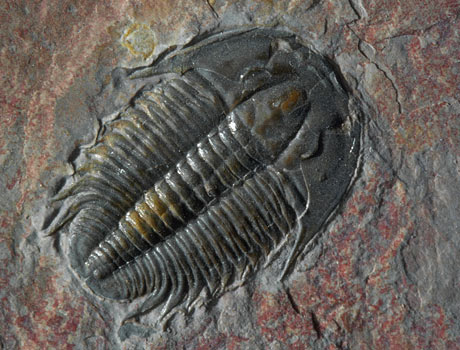
It was Mr Magoo that did it for me. “Dr Rousseau H. Flower was an eccentric in the grand manner … he always wore hand-tooled cowboy boots with elaborate curlicues in the stitching and a hat and jacket to match. He was very shortsighted, and tended to stumble along in the purposeful way adopted by the cartoon character Mr Magoo, while mumbling vigorously to himself.”
The Magoo lookalike also carries a whip and a six-shooter, but that is not what matters most about him: what matters is that he was an expert on the nautiloids of the Ordovician.
The nautiloids are now turned to stone: little fossilised inscriptions that spell out an enigmatic narrative. The world around us is a text, a memoir, a record of its own history. Its condition is rather battered, lots of pages are missing, the script is barely legible, the language incompletely understood and the storyline uncertain. Science provides the basic grammar, a rudimentary lexicon and a series of provisional attempts to fill in the gaps.
Richard Fortey’s Life: An Unauthorised Biography, the Guardian Science Book Club’s inaugural title, is a big read in every sense: its 400 pages span four billion years of planetary existence and 400 years of systematic scientific investigation. Its very ambition makes it a good candidate for interesting questions. What, exactly, is a science book? And to be a good book, does a science book have to be well-written, in the sense that a literary novel has to be well-written?
The answer to the first question is a slippery one: a science book can only be as good as the science in its pages. Science, however, is not a static thing. Research moves on, paradigms shift, fresh discoveries open new approaches so swiftly that what was once the last word on the subject can become little more than science fiction in a decade or two.
The answer to the second question is not straightforward either: clarity is a minimum requirement, followed by a serving of scholarship phrased in language that does not patronise, but does not confuse. A book that starts with slimy things in the pre-Cambrian oceans and continues to the dawn of human civilisation in the Fertile Crescent must offer more than just a procession of challenging concepts and unfamiliar words, and accordingly up pops Mr Magoo, with whom Fortey (himself big on the trilobites of the Ordovician) once shared a hotel room.
Magoo is a digression, a little eddy in the mainstream of the narrative. He crops up in a discussion of fossil eccentricity: Fortey uses Rousseau H. Flower to illustrate success within a life of eccentricity. The weird creatures from the peculiar world of the Cambrian, says Fortey, would also have seemed appropriate to their environment. So Mr Flower Magoo becomes a casual, unforced little object lesson in life’s improbable procession.
The book is full of affectionate touches and gentle concessions to anthropomorphism, even during extended lectures on scientific objectivity and scholarly honesty. As animal life begins to colonise the continents, Fortey invites us to “imagine ourselves as that first doddering tetrapod, to feel the need for breath, or to imagine ourselves sliding beneath dark, damp vegetation to escape the worst of the Sun’s intentions.”
But, of course, that’s not the way to think. Fortey admits that it is almost “impossible to filter out the idea of will to succeed from my narrative of life’s changes …” This digression ends with a reflection of scientific fraud and a reminder of the stony message from the silent Earth. “In Nature … there is no sin. Nor can Nature cheat.”
Books like this are a reminder of what good books must be: texts that inform our ignorance, and at the same time sympathise with our failures of understanding. They are companionable journeys towards the light. They address us as friends, not pupils. Fortey’s book is a journey in four dimensions: across the Oman desert, in an alehouse at Church Stretton, on a beach off Spitzbergen, but always in pursuit of some mysterious, improbable, distant past. So it is a travel book, a personal memoir, a reflection, and a history as well as a sustained and compelling lecture on yesterday’s planet and today’s biodiversity.
Mysterious creatures with suitably daunting labels (such as chemolithoautotrophic hyperthermophiles) may begin life’s dance, to be followed 120 pages later by eurypterids – frisson-inducing water scorpions that grew up to six feet long and lay in the Devonian mud, waiting for unwary prey. At every level, the scholarship is spiced with sympathy.
Which brings us back to my original and not-quite-idle question: if it is all these things, in what sense is it a science book, rather than just a really good book?
In the coming month the Science Book Club tackles something completely different: Graham Farmelo’s new biography of the British physicist Paul Dirac, The Strangest Man (Faber). Dirac is noted for his work applying relativity to quantum mechanics and his prediction of the existence of antimatter. But, as the title says, he was also a profoundly odd human being ... That discussion kicks off on Friday 3 April.

